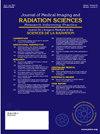Exploring factors behind first-year radiation therapy students' decision to pursue the profession at english-language institutions in Canada
IF 1.3
Q3 RADIOLOGY, NUCLEAR MEDICINE & MEDICAL IMAGING
Journal of Medical Imaging and Radiation Sciences
Pub Date : 2025-04-18
DOI:10.1016/j.jmir.2025.101906
引用次数: 0
Abstract
Background
Radiation therapy departments experience an imbalance of patient volumes with insufficient staffing. Limited research exists about factors influencing individuals' desire to pursue a career in radiation therapy. Therefore, this study aimed to explore the factors behind first-year students’ decision to pursue this profession in Canada.
Methods
A cross-sectional electronic survey was distributed to first-year radiation therapy students in Canada through program directors of each Canadian institution. The survey contained closed and open-ended questions for comprehensive insight and were developed through extensive literature reviews.
Results
A total of 33 complete responses were obtained. Primary reasons for choosing a career in radiation therapy included a desire to help others (16.8 %), interest in the healthcare field (16.2 %), and job stability (15.1 %). Influential factors guiding respondents’ decisions were university resources (22.9 %), reading articles related to radiation therapy (22.9 %), YouTube videos about the profession (21.7 %), and other online resources (18.1 %). Two themes were identified when respondents were asked what would have made radiation therapy more appealing as a career: public profile and accessibility.
Conclusion
While research dedicated solely to radiation therapy remains limited, drawing inspiration from recruitment strategies and resource allocation models utilized in other allied healthcare professions can be invaluable. Shared factors like altruism and job stability justify integrating radiation therapy into broader healthcare recruitment initiatives. Targeted recruitment campaigns and accessible resources can raise awareness about the profession. Further research is warranted to explore these factors.
探索一年级放射治疗学生决定在加拿大英语机构从事这一职业背后的因素
背景:放射治疗部门在人员配备不足的情况下患者数量不平衡。关于影响个体追求放射治疗事业的因素的研究有限。因此,本研究旨在探讨一年级学生决定在加拿大从事这一职业的因素。方法通过加拿大各机构的项目主任对加拿大一年级放射治疗专业学生进行横断面电子调查。该调查包含封闭和开放式的问题,以获得全面的见解,并通过广泛的文献综述而发展。结果共获得完整应答33例。选择放射治疗职业的主要原因包括希望帮助他人(16.8% %),对医疗保健领域的兴趣(16.2% %)和工作稳定性(15.1% %)。影响受访者决定的因素是大学资源(22.9% %)、阅读与放射治疗相关的文章(22.9% %)、YouTube上有关该专业的视频(21.7% %)和其他在线资源(18.1% %)。当被问及什么会使放射治疗作为一种职业更有吸引力时,受访者确定了两个主题:公众形象和可及性。结论:虽然专门针对放射治疗的研究仍然有限,但从其他联合医疗保健专业的招聘策略和资源分配模式中汲取灵感是非常宝贵的。利他主义和工作稳定性等共同因素证明,将放射治疗纳入更广泛的医疗保健招聘计划是合理的。有针对性的招聘活动和可利用的资源可以提高对该职业的认识。有必要进一步研究这些因素。
本文章由计算机程序翻译,如有差异,请以英文原文为准。
求助全文
约1分钟内获得全文
求助全文
来源期刊

Journal of Medical Imaging and Radiation Sciences
RADIOLOGY, NUCLEAR MEDICINE & MEDICAL IMAGING-
CiteScore
2.30
自引率
11.10%
发文量
231
审稿时长
53 days
期刊介绍:
Journal of Medical Imaging and Radiation Sciences is the official peer-reviewed journal of the Canadian Association of Medical Radiation Technologists. This journal is published four times a year and is circulated to approximately 11,000 medical radiation technologists, libraries and radiology departments throughout Canada, the United States and overseas. The Journal publishes articles on recent research, new technology and techniques, professional practices, technologists viewpoints as well as relevant book reviews.
 求助内容:
求助内容: 应助结果提醒方式:
应助结果提醒方式:


